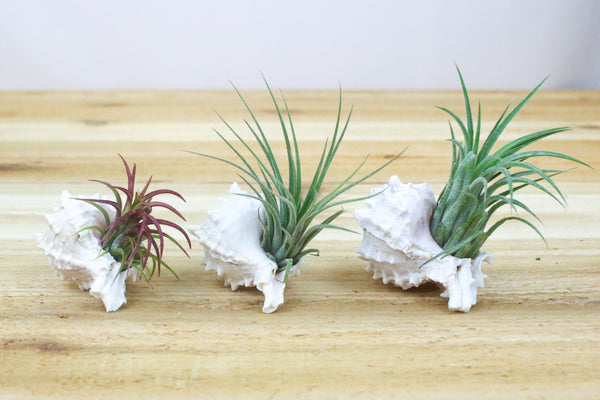Inspiration for Displaying Your New Tillys
Air Plants are extremely versatile when it comes to displaying and design in your home since they do not require dirt, heavy containers, or a large space to grow.
1. Glass Terrariums
Glass terrariums are perhaps the first thing that you may consider when you visualize displaying your air plants. They are simple, easy to install, and the contents of the terrarium can be easily changed out for a new look or season.
There are 2 main types of glass available, either those that are suspended in air as hanging terrariums or those that have a flat bottom for placement as accent pieces on tables and shelves. Among these two types, the sizes and design possibilities are endless. Some choose to keep their glass terrariums relatively simple, with the glass’s only resident being an air plant. Others are inspired by an air plant’s natural surroundings, adding stones, moss, tree bark, or sand. On our website you are able to purchase several beautiful terrarium arrangements.

2. Grapevine, Mopani, & Driftwood
In their natural habitat, air plants are often seen attaching themselves to the sides of trees, stones, and rocky cliffs. Utilizing different wood media, you are able to easily and beautifully recreate these natural displays. Perhaps you collected a beautiful piece of driftwood along the coast years ago. You could easily freshen it up with air plants. “Domestic” air plants will need a little help attaching themselves to the wood. The most common type of “Tilly” glue sold is formula E-6000 which is waterproof and most importantly safe for air plants. Mopani wood and Grapevine wood are two special typea of very hard wood used in home decor. Although getting rare and harder to find, they are worth purchasing if you really want to make a statement.

3. Cork Bark
Cork bark is one my favorite ways to display air plants! Cork Bark Trees, Latin: Quercus suber, is the species of tree which is used to manufacture corkboard and wine corks (at least the old fashioned kind). It's a renewable medium since the bark is regenerated on the sides of trees after it is stripped off. The cork is harvested without harming the trees and crops can be harvested every few years once the tree reaches maturity.
Cork bark is commonly seen in vivariums and terrariums, and the cork bark that is available to air plant enthusiasts can easily be cut to size for flat wall hangings or table displays. It's a great material due it's durability, relatively light weight, and uniqueness! It is simple to press loop hooks and screws into the back of the cork bark for easy mounting. Cork bark pieces are sold in our store in several sizes and with or without plants. Air plant-safe glue is included with every order of cork bark. Cork bark is a great material for creating vertical gardens!

4. Seashells, Urchins, & Natural Containers
Another option for displaying air plants are natural containers. What do I mean by that? There are plenty of natural curiosities that are the perfect size to hold an air plant. Many of the most common are from the ocean. Various seashells and urchins (which are already cute to look at) have small holes that easily fit an air plant. Urchins and air plants making the cutest pairing. Larger species display nicely with conch shells. If you are not going for the beach look, seed pod containers and small wood pots offer cozy homes for Tillandsia. Containers of all sorts can be painted to match your decor.

5. Vertical Gardens
Vertical gardens are booming (blooming?) and for good reason. They are stunning creations. But, with air plants, vertical garden displays do not have to be complicated. Some air plant vertical gardens are a simple wire mesh with air plants pushed into the openings. Many designs use antique picture frames or re-purposed wood framing. They are highly customizable when it comes to size, desired color scheme, and texture. To start your very own vertical garden, I'd recommend our bulk variety pack of 33 large air plants.









